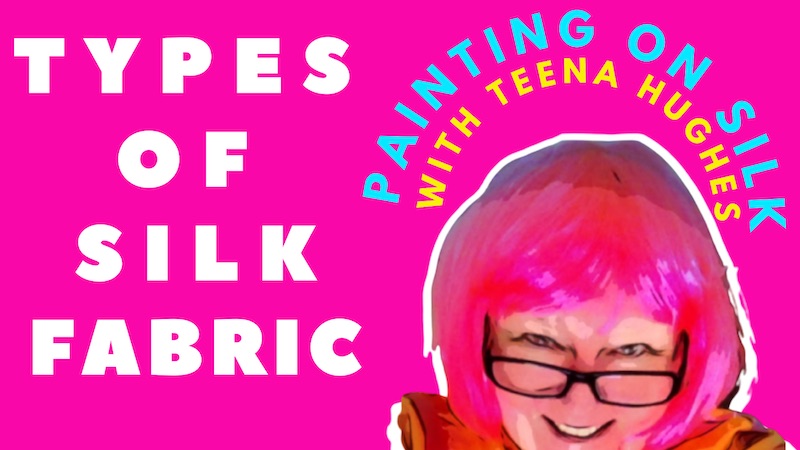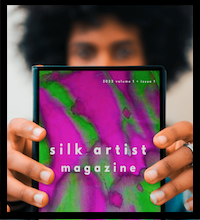 Let’s talk about Types of silk fabric with names
Let’s talk about Types of silk fabric with names
This is Teena Hughes from how-to-paint-on-silk.com
I’m just getting ready for a Zoom chat with some people interested in silk painting and others who are already painting on silk, and just want to talk about the projects they’re working on. So it’s very exciting. Oohhh!
Anyway, I just wanted to say a big hello and do please click on the link to chat with me on Zoom. We can schedule a date and time — I’ve already got some dates set up, so that would be great. Don’t be shy.
I’d love to see what you’re working on
And I’ll always have a bunch of things to show you that I’ve been painting. Some clothing — silk of course is very slippery, so it’s sliding off my desk.
Just some fabulous designs I’ve been making in all kinds of crazy designs, not necessarily with Gutta — mostly without a Gutta product, but let’s see. I like doing really random geometric, exciting designs like what I’m wearing.
This is one of my hand painted silk coats and I call them Haori jackets. And I just love the effect that you can get by just using two colours. Three of course is, is good, but this for example is just two colours, but depending on where one color touches the other, it becomes a third color.
So anyway, so much to talk about! So exciting!
I just thought I’d show you some of the silk that I have painted and maybe talk about the fabric. In this one, this is a top that I’ve created and it’s a big girl top because I’m a big girl. It’s blue and green with a bit of purple and some white cold wax.
And I just wanted to show you the fabric. Here are some of the types of silk fabric I uaw – with names.
Silk Twill • great for men’s shirts and ladies’ tops
Now this type of silk fabric is called Silk Twill, so it’s got a little tiny bit of stretch in it, depending on which way you pull it, but it’s nice and cool. And I love it.
Habotai Silk • shiny and light
Habotai is one of the main types of silk fabric which everyone learns to pain on as a Beginner – including me!
And as you may or may not know, I normally live in tropical areas and right now in Australia I’m about two thirds of the way up the east coast, so it gets pretty hot in summer time. And so I’m always looking for something that isn’t too hot, so obviously a tight-weave silk like Habutai I can’t wear for most of the year because it just makes me sweat, but perfect for Alaska, or if you live in a cold place. If you live in Canada or anywhere in Europe, Habutai is fantastic in winter because it’s such a tight weave that the air doesn’t go through the silk, and so it’s a good, good thing to know.
Sand-washed silk • shiny on the outside
Now this one is a top that I’ve been making hot pink and lime green with my usual random designs. This is just a slip-on top; I haven’t finished the neck yet. This is in a silk called sand-washed silk. Now it’s really shiny. It feels very luxurious. It’s thicker than Habutai and thicker than Silk Twill. And it’s shiny on one side and matte on the inside. I don’t know if you can see the difference there. So that’s the matte side and that’s the shiny side and I just love it. It’s called sand-washed silk.
Some people have contacted me over the years and said that they can’t find it. I don’t know. It might have another name where you are, but you can talk to the people selling the silk and ask them for a silk that is shiny on one side and matte on the other side (so that means not shiny). And you can just feel it – it just feels so fabulous against the skin. I love it to bits, and I’ve made a lot of clothing (and sold a lot of clothing) made out of this particular silk – and scarves, so you can do lots of things.
Silk Cushion Cover
I’ve got some other bits here that haven’t been ironed, but just things that I’ve been practicing with. So for example, this is a cushion cover. It’s not ironed it’s, as I said, it’s a bit messy, but it’s a cushion cover all in one long piece because it’s been stitched together, two pieces stitched together with a zipper. And so you can see here, here’s the zip.
So I painted flat stretched on a frame of course, and then all I’ve got to do after I’ve steamed it is I turn it inside out, and then I do these three sides. I stitch the three sides and it’s ready to go. So it’s a quick and easy cushion cover.
Silk Cushions can be made from many types of silk fabric – I used to use Habotai, but now I use sturdier, stronger silk which will last for many years to come.
Flowers on Habotai
Here is just a little bit that I was playing with trying some new little dabbles, just doing flowers without any outliner and there’s one there. And so if I was going to turn this into something, I might then take a silk or permanent pen and draw on top in either a colour or black (because I love black outlines). And so that’s fun.
Hand-painted Silk Chiffon Top
And then here’s one I’ve made well, gosh, I don’t know, 20 years ago, this is one of my first tops that I ever created. And it’s just got an open neck and it’s got three quarter sleeves and it’s in turquoise and green. Now this is it’s got little slits up the side and I just love this because you can wear it over a tank top (like right now I’ve got a black tank top on). So I could wear this over that. And it’s just because it’s soft and lets the air flow through, this is great in hot climates or warm climates.
My tip for big baggy sleeves (to avoid door knobs!)
Now here, what I’ve done with the sleeves, because I’ve got little skinny wrists and tiny hands. Haha that sounds funny! I’ve sewn up the sleeves and only left enough my hand to sneak through. And I’ve done that because as much as I love big baggy sleeves, I got really tired of getting caught on door knobs and other bits of furniture.
So I stitched up the edge of the sleeve and just left my hand poking out through the top where it wasn’t going to cause any danger. So that’s just a little tip for those of you that sew. I just love that, that silk chiffon, and that comes in many thicknesses, just like Habotai, like every other fabric.
Crinkle Chiffon – looks so great!
This is just another one that I’ve used, although I used to love painting on it was crinkle chiffon. So same as this, but it’s totally crinkled when you buy it. And you know, when you stretch it and it gets wet with the dye, of course it goes flat, but after you’ve steamed it and washed it and let it dry, it then goes back to being crinkly.
So I had, for quite a few years, I was making, um, crinkle, chiffon clothing nonstop. When I say clothing, I mostly make big tops, big coats like this, Haori jacket, big floaty things, scarves. And it was really beautiful to work with. So that’s another, if you haven’t heard of, you can check that out.
Small Habotai Silk Sample on a Wooden Frame
Now, for those of you who might be new to silk painting I have a little demo here just to show you what I use for silk painting. Now I use artists’ stretcher bars. I’ll just show you along the back here
And you buy these in all different lengths. This is a small one, which is perfect. So if I just want to do a couple of quick little designs or make cards, for example, I can use this little short one.The size – I usually have the size on the bars, oh these are 14 inch, which happens to be 35.6 centimeters. I often get confused with sizes because I was brought up with Imperial measurements. Then we went metric. Then I moved to the States, so I was back to Imperial sizes. Then I lived in France, so I was back to metric. So yes, my brain is just a hodgepodge of different countries in different sizes.
So then what I’ve done here, I’ve just stretched it and I’ve left a bit of silk on the end. I didn’t cut it off, for no particular reason, except I didn’t feel like it.

How I attach the silk to the wooden frame with Pins
And then once I start to stretch the silk, I use these pins. Now I call these thumbtacks in Australia. (I’ll get it against whites so you can see.) These are thumbtacks. I think some countries, maybe in the States, they’re called push pins – they are fantastic to hold the silk onto the wood. And I liked them because they’re easy to push in and easy to pull out.
Now with the claws, which I also love — silk claws these are called – they have three prongs. They’re normally about a dollar each, I think, plus shipping, you buy them in a little box of 12 and you can buy those in all kinds of places. They’re called suspension claws or silk claws or hooks depending on where you’re buying them from. But you can find those easily online.
Eyedroppers are my friends 
This is a fabulous little do-hickey that I use. I’ve got a ton of these. This is for when I’m mixing colors. So this is like an eyedropper I can suck up one dye and then mix it with some water to get another color or mix it with another dye color to get a different one. So these are great and you can find these on Amazon and everywhere.
Holding smaller bottles during silk painting
And then usually I buy my dyes or I mix my dyes and when I’m painting, I like to paint with small bottles. So I just find these online, they’re small bottles and I always make sure they have a well-sealed lead. So you need to mention that when you’re buying them, because if they tip over, you don’t want them to be able to leak. Some bottle tops do not have the little padding inside to stop the leakage, so be alert for that. So I normally hold three or four in my hand, and then I have paint brushes in the other hand that I’m painting with and yes, I do hold my paintbrush and quite often I’ll put a paintbrush through my teeth like this and it’s not pretty to look at, it never is, but I’m in another world, so that’s okay.
So that’s what I do with the dyes and bearing in mind that I only use silk dyes that need to be steamed set as well.
Paintbrushes for Silk Painting
Now, here are some of my brushes. I use a different brush for each colour and if you’ve watched any of my videos, you’ll know how I lay out the paint tray so it makes it really easy to find. And then I’m just looking at a couple of others in here. So we’ve got these hard brushes like this, this one is acrylic. This one is so a lot of the others are hair. But yes, you can buy fake hair ones now that are very good. So with these, I use mostly with the cold wax or if you’re using an outliner or a Gutta and that way, when I’m using them, it’s a nice hard edge.
The other brush is very soft, so they’re not very suitable to the outliners. And yeah, so, and I have those brushes in all shapes and sizes. Like even down to this eeny weeny teeny one I’ll hold it against something, you can see it against and yeah, so you can buy really cheap brushes to play with, before you start spending a big money on fabulous paintbrushes for silk painting.
Let’s chat about what you’re working on – join me on Zoom!
Anyway, do please sign up for one of my upcoming Zoom chats and I look forward to seeing more of you soon. Okay have a fabulous week! Caio ciao for now!

This is Teena Hughes from how-to-paint-on-silk.com
Bye-bye!
Oh, I almost forgot! If you’re watching this video on YouTube, how about clicking the Subscribe button and the little bell, so you’ll be notified as soon as I post new videos, that’d be fantastic. Okay. Bye-bye!
Did you enjoy this video about Types of silk fabric with names for silk painting?
If you have any questions, please do get in touch – here are a couple of ways to do that:
- contact me on Facebook
- contact me on Youtube
- contact me by writing an email
- send me a voicemail on my website – there is a long button on the right hand side of the screen
See you soon!
Teena!














